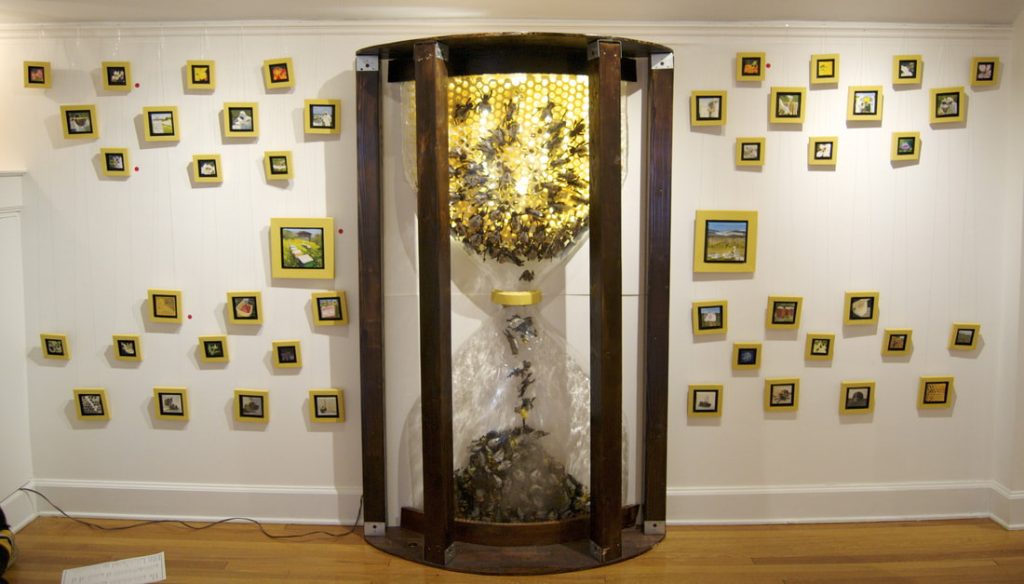In May of 2012 I came across a listing for art submissions for a show called “Plight of the Pollinators.” I began reading about the disappearance of honeybees and the mysterious phenomenon of Colony Collapse Disorder (CCD). With a little research I found out that since 2006 around 30% of honeybee colonies are dying each year in the United States, with losses greater than that in some areas. I found no clear answer as to the cause of the collapse, but the bees had captured my attention. I produced “Vaya con Dios and Daisies” in response to the call for art, but was unable to let the bees go and they became the focus of my art for the next two years. In April, 2013 I launched a Kickstarter campaign to raise funds to have time to produce my first solo show and to raise awareness and involve my community in the production of what became The Hive Project.
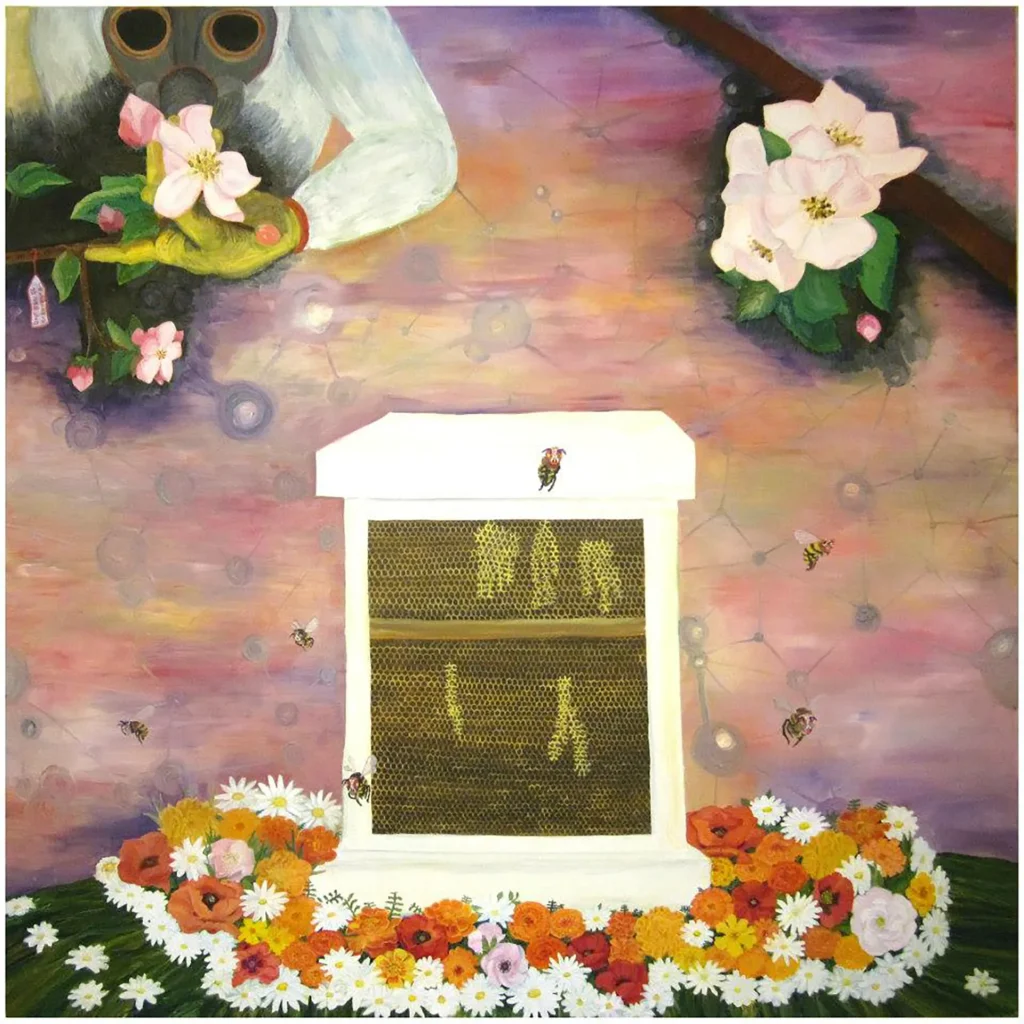
I painted “Vaya con Dios and Daisies” in response to that call for art. At the center is an empty observation hive, surrounded with flowers typical of Dia de los Muertos, the Mexican Day of the Dead, altars. Flying away from the hive are six bees wearing masks painted in the same fashion. To the upper left, an ominous figure in a hazmat suit cradling an apple blossom. Hanging from the branch is a tag labeled “Burbank-X 12-798GMO.” The background evokes sunset and microscope slides of genetic material. One of my favorite paintings by Frida Kahlo is her Portrait of Luther Burbank from 1931. Burbank was a horticulturist who made great advances in crossbreeding plants, breeding for traits. He invented the Shasta Daisy by crossbreeding daisy type flowers from four continents, breeding for his ideal number of petals, precise yellow centers, and the purist white like the snow of Mt. Shasta. Kahlo was disturbed by his invention of plants, and portrayed Burbank as half man, half tree, with roots feeding on a human corpse below the surface of the ground. Behind him she painted apple trees with abnormally large fruits, and indeed Burbank bred apples and dozens of other fruits and vegetables to make them stay fresh longer, taste better, be brighter colored, and bear more fruit. In my painting, the genetically modified strain of apples is named for Burbank, and designed to tolerate the use of harsh pesticides in order to produce the sweetest, most crisp apples. However, the chemicals in this orchard are so toxic that the farmer can only inspect the trees in a hazmat suit.
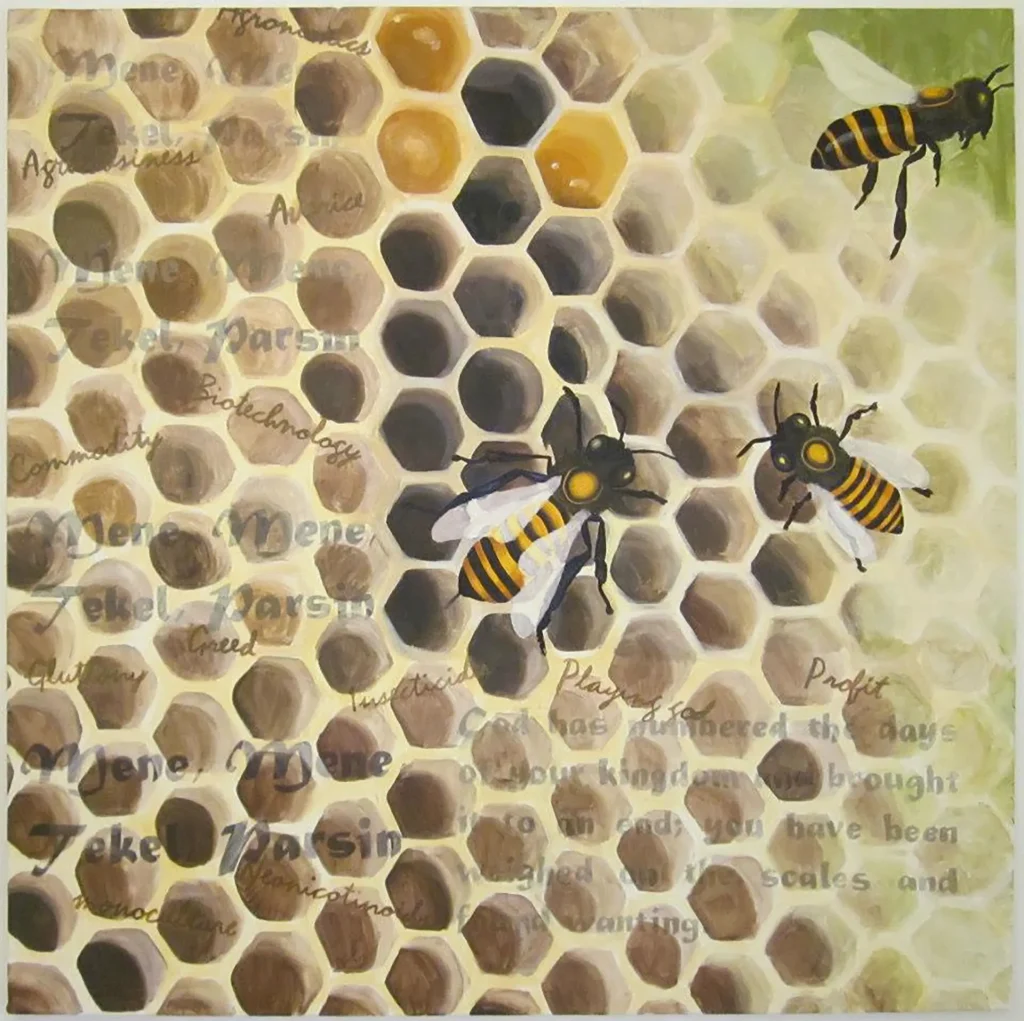
“The Writing on the Wall” includes text from the Book of Daniel: “Mene, Mene, Tekel, Parsin: God has numbered the days of your kingdom and brought it to an end; you have been weighted on the scales and found wanting” and words like “agribusiness, playing god, pesticides, monoculture, greed…” written on the wall behind the honeycomb. Nearly all of the cells of the comb are empty, and only a few bees remain. The term “the writing is on the wall” has come to mean the foreshadowing of doom and destruction. The honeybees disappearing from CCD are the writing on the wall: honeybees are not the only or even the most important pollinators of our food chain. They are however, the only pollinator that has been domesticated and can be easily tracked and most importantly, have their own industry and economic impact. We didn’t notice CCD because crops are failing, it was because the beekeepers who transport large hives along a cross-country circuit noticed that their bees were leaving the hive and never coming back, and their hives were dying. The leading research implicates a class of pesticides called neonicotinoids that interfere with the bees’ ability to communicate with each other, leading to hive abandonment and starvation. Even when the pesticide is applied in doses that are not immediately lethal to bees in the environment, it interferes with their ability to pass information on the location of food to their colony, and appear to weaken their immunity to a virus that makes them more susceptible to varroa mites that feed on baby bees while they develop. No one knows what these chemicals do to other pollinators such as butterflies, moths, wasps, or ground bee. If we do not listen to the writing on the wall and continue towards pollinator extinction our food source is doomed.
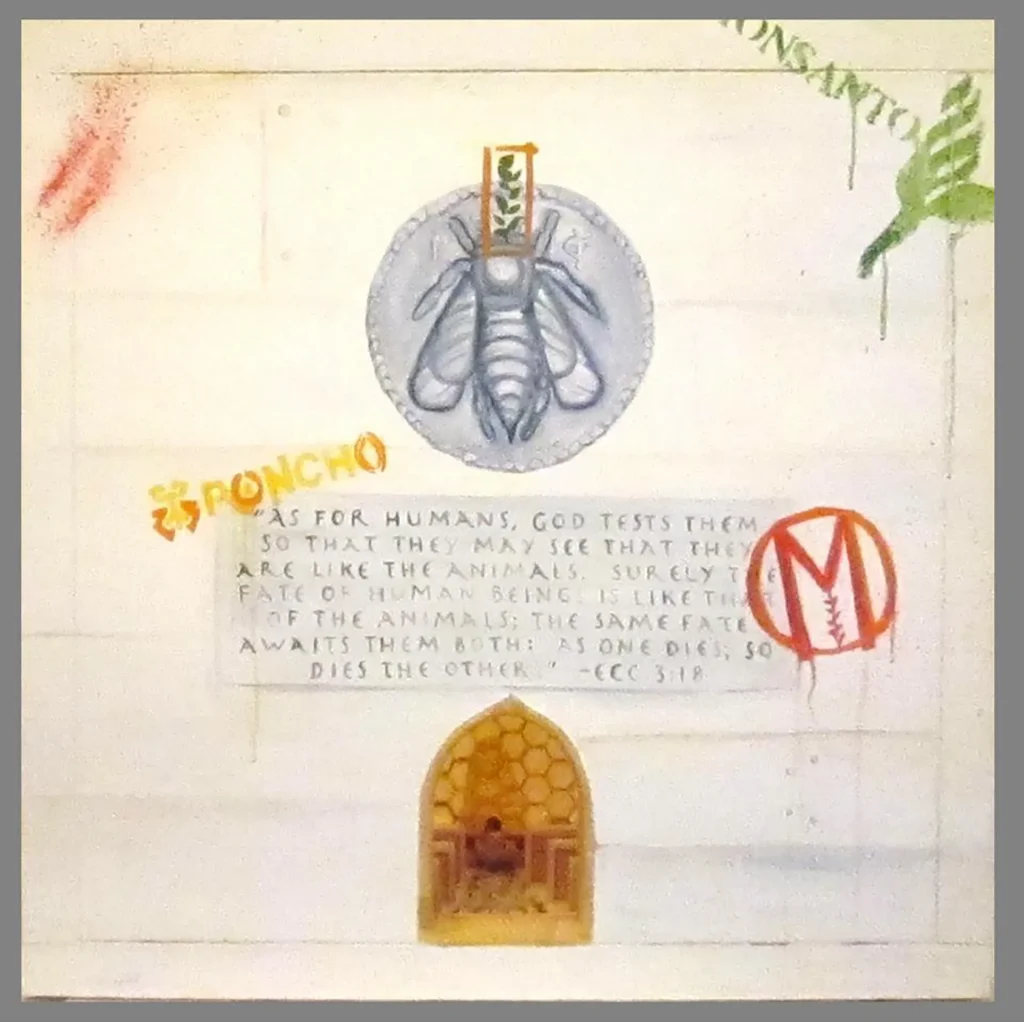
Desecration of the Hive Oil on canvas, wood, drawing, glass, beeswax.
“The Desecration of the Hive” is an interactive piece with more to be discovered inside. A combination beehive and church, the text comes from the Book of Ecclesiastes “As for humans, God tests them so that they may see that they are like the animals. Surely the fate of human beings is like that of the animals: the same fate awaits them both – as one dies, so dies the other” Ecc 3:18. The graffiti symbols on the outside are brands of pesticides that produce Neonicotinoids and are fighting desperately to prevent the ban of their use: despite the fact that bans of neonicotinoids in parts of Europe have resulted in rebounding bee populations in areas hard hit by CCD. Inside the box are pews made of honeycomb, and a large stained glass wall depicting the tree of life shaped to mimic the pattern of the waggle dance the bees use to communicate, and a drawing of the dance. On the alter at the front of the church is an offering of pollen.
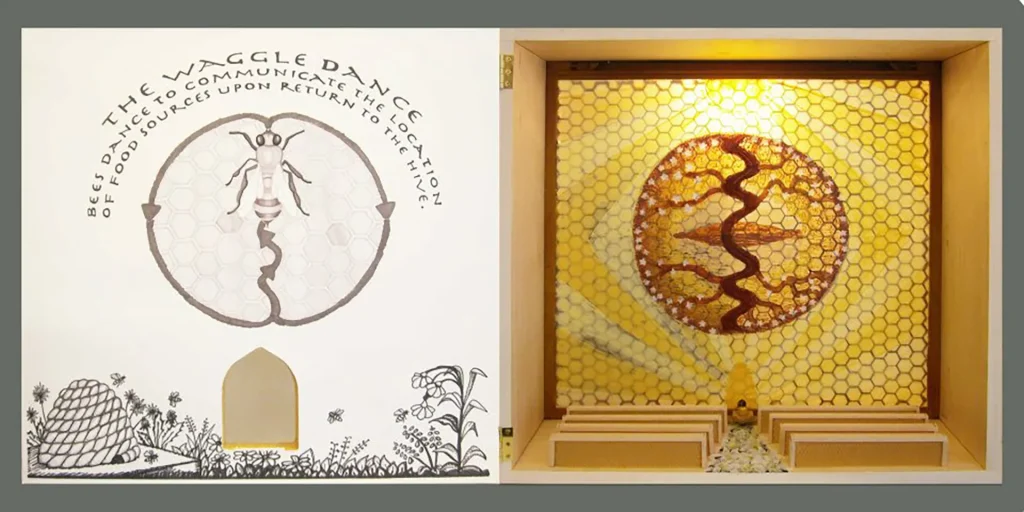
In April 2013 I launched a Kickstarter campaign to raise enough money to work as an artist fulltime for five months. I designed the project so that donations of different amounts funded paintings on different sized canvases. Donations up to $225 each sponsored the production of a painting in the Hive Project and larger donations sponsored the production of the sculpture. The number of contributions at each level determined the quantity of each size painting. The campaign was successfully funded May 26, 2014 and I started the process of designing the Hive Project with the input of 92 backers decisions determining canvas sizes.
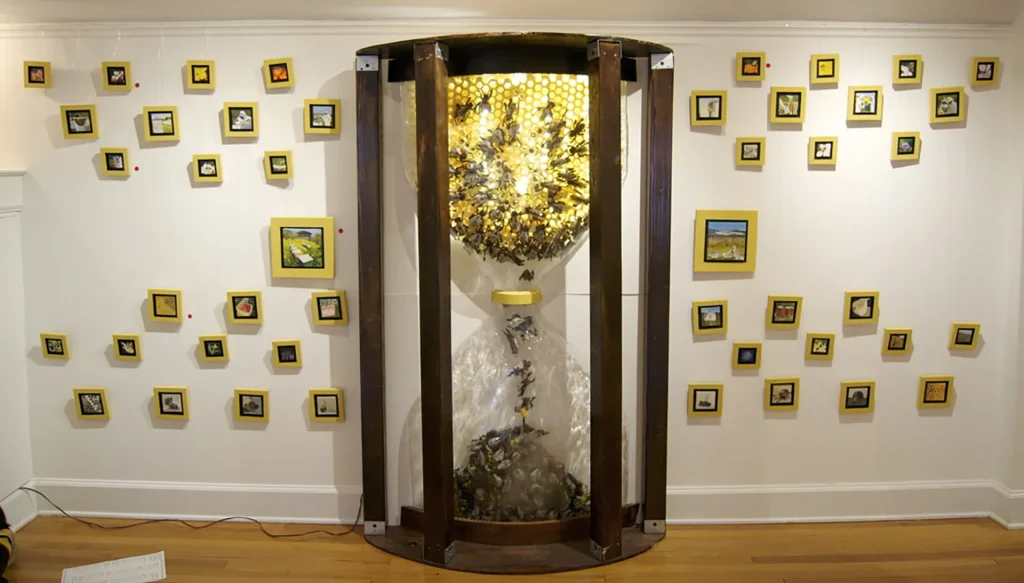
I began with the idea of an hourglass, as time is running out to save the bees. All of these painting surround an hourglass. The top of the hourglass represents life with bees, and is filled with a colony of bees. The bees are crowded around an open space occupied by a single bee as she performs the waggle dance to tell them were the best source of food is. As the bees near the base of the funnel, they are clinging to the comb, desperately trying to fight the fate that awaits them if we do not change our approach to agriculture. The bees streaming into the bottom, piling up represent those lost to Colony Collapse Disorder.
I gathered images of healthy farms and farming techniques, of organic bee keeping, and healthy foraging bees, and images of equipment spraying pesticides in orchards, chemically coated seeds. I made lists of things we would have to do with out if we failed to save the bees: apples, berries, pumpkins, grapes, olives, oranges, almonds, squash, sunflowers, watermelon… I thought about non-food based cultural implications: imagine reading your favorite fairy tale to a child who doesn’t know what an apple is? “So the evil queen mixed up a terrible magic poison apple that looked beautiful and red and sweet to bring to Snow White,” you read, and feel a tug at your sleeve and you hear a little voice say, “Mommy, What’s an apple?” or the fairy godmother who turns a pumpkin into a grand carriage… We are not far from a world in which “Once upon a time there was an apple, a pumpkin, a beanstalk, grapes, berries, peas…” I juxtaposed images of pesticides being applied with kids in gardens and orchards; healthy bees and dead bees; and beekeepers with fields labeled “danger: pesticides, do not enter”, “pesticides in use: proceed at own risk” and dead abandoned hives.
Thank you to all of the people who made this project possible by participating in the Kickstarter campaign:
Contributors:
Abe Drayton, Ellie Andrews, Devin Elgert, Lindsay Freese, J. Fribush, Lewis Clark, Sab Will, Meg Jones, Jim Giddings, Kristna Evans, Chris Jorgenson, Lauren Conway-Russell, Allison Kirby, Joan Deppe, Sarah Jane Penn, Julie Kessler, Laurel, Britta Reida, Maryellen Kurkulos, Edwin Fransen, Ben Guaraldi
Supporters:
Kevin Winter, Sarah Hubner, Kim Lefebvre, Katrina Rogachevsky, Claire Mershon, Sadie Forsythe, Andrew Yager, Kay Siebler, Ella Yager, Gregory Holt, Douglas Frazer, Anthony Petrillo, Tom Antonik, Benjamin Yager, Kyle West, Clarissa Mulliken, Jason and Marie Gasper-Hulvat, Gail Haines, Owen Courisn, Pandora Young, Richard Kleinschmidt, Frederick Martin, Jim Fauntleroy, Andrew Adams, Holly, Lucy Meadows, Sara Burke, Seth Alexander Prestwidge Barch, Hannah Zwirner, Gretchen Backer-Smith, Logan Druckman, Samantha Mills, Denise Ginzler, Emily Taber, Jack Snyder, Kathleen Mercer, Anne Landis, Kathryn Eldred, Becky Winkler, Jane Broadbent, Gwen McEntee, Tim Eliot, Erin, Hallie Yeager, Hannah Woodward
Sponsors:
Pedro Zavala, Ashley Curet, Rev. W. Allan Knight, Bill Berling, David Yager, Sara Smith, Jeanie Holt, Jay Smith, Margaret Pruitt, Juli-Ann Gasper, Kathy Koplik, Johanna Riodan, Eleanor M. Cappa, Lisa Graustein, Joyce Miller and Mary Norris, Sarah Morenon, Stephen Holt, Suzie Yager, Ben Holt
Collectors:
Katherine Lessuck, Jonie LaBombard, Debbie Humphries
Benefactors:
Martha Yager, Rob Yager, Donna Moore, Maranda Greenwood

